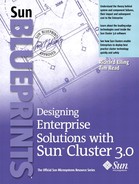Technologies for Building Distributed Applications
Many technologies exist for building cluster environments or creating distributed applications. The sections that follow describe examples of two such technologies.
CORBA
Probably the best known technology for building distributed applications is the Object Management Group Common Object Request Broker Architecture (CORBA). First released in October 1991, CORBA 1.0 defined an open, vendor-independent architecture and infrastructure and not a specific product. This architecture and infrastructure enables companies to compete on implementation of the specification but remain compatible and interoperable. Object request brokers (ORBs) are currently available from Inprise, Iona Technologies Ltd., IBM, and BEA Systems, among others [ORBimpl]. The latest CORBA 3.0 release includes standardization for fault-tolerant redundant software configurations through entity redundancy at the object level.
CORBA also defines an interface definition language (IDL) for specifying the parameters to be passed to and from an object when a particular method is invoked on it. The strong interface definitions of IDL form a contract between the client and the server-side object implementation. Relying on these definitions shields users and consumers of the interfaces from the actual implementation of the object. This shielding enables users to replace the object with newer or better implementations without affecting the applications that rely on it. It also means that objects can be written in any programming language that has IDL mapping, for example, C/C++, Java, COBOL, and so forth. In turn, these languages can reside on a wide range of hardware platforms and operating environments.
Programs locate the object they want to use through a name service. Once the particular target object is found, communication between them is independent of their location. The Internet Inter-Orb Protocol (IIOP) facilitates communication between ORBs.
For more information on the Object Management Group, see http://www.omg.com. For more information on CORBA, see [CORBAhist].
JXTA
Started as a research project by Bill Joy and Mike Clary, JXTA (pronounced “Juxta”) was released by Sun in the spring of 2001. JXTA is a set of open, generalized peer-to-peer protocols. These peer-to-peer protocols enable any connected device on the network (for example, cell phone to PDA or PC to server) to communicate and collaborate. JXTA is independent of programming language, communication protocol, hardware platform, and operating environment, giving it the widest possible developer audience.
Applications like Napster and AOL Instant Messaging have their own infrastructure and protocols for communication and service location. JXTA can provide a common framework for both of them, enabling a higher degree of integration.
For more information on JXTA, read [JXTAover] and see http://www.jxta.org.
